The Problematic World of the Navy’s Second Century
It is widely recognized that predictive analyses are fraught with difficulties. As one commentator observed, “we know a great deal but we understand very little.”1 Can we project trends into the future in a linear manner? At what stage are feedback loops triggered? And how are we to account for human agents whose decisions may be rational or not? Certainly, we have come to recognize that causation is increasingly multivariate and synergistic. The challenges to be examined are twofold: what will the world be like in the foreseeable future (say, out to 2025); and what will changed global circumstances mean for the Canadian Navy in terms of its character and operations?
Accordingly, this chapter is divided into two parts. The first part analyzes the major factors that are likely to shape our world almost two decades hence. Those factors include demography, resources, environmental trends, and geo-strategic developments. The second part analyzes the Canadian domestic scene in terms of defence policy and the ways in which the Canadian Navy will develop and be employed in 2025.

Future warships in the Canadian fleet may yet come to include designs such as artist Geoff Bennett’s 1984 interpretation of a large helicopter-carrying SWATH ship.
The forecast is sobering, even bleak. The twentieth century was an exponential century. Its great icons were the atomic bomb, the birth control pill, the space shuttle, and the internet. During the century, mankind’s ability to kill became global and instantaneous for the first time in history. At the same time humans were able to tinker with demography as never before. We looked back on earth from outer space and realized that the philosophical underpinnings of the Western concept of progress, of moving onward and upward endlessly, no longer applied. The world, in the largest sense of the word, was finite, not infinite. There was a stern corollary associated with this realization; that we were being driven inexorably from cultures of consumption to cultures of conservation. And news of that phenomenon could now be communicated anywhere on the face of the planet in the blink of an eye. All of these disparate realities were captured by the term “globalization.” Globalization was predicated, in large part, on neo-liberal expectations of the primacy of democracy and free market forces, phenomena telegraphed with dramatic speed and power to every corner of the earth.
Mankind is on the cusp at the beginning of the twenty-first century. While the denizens of Western Europe in the late 1340s no doubt concluded that the Black Death heralded the end of the known world, their travails were, in retrospect, less existential than the ones facing their descendents over six centuries later. The catalogue of challenges facing mankind in this century is daunting and those challenges are, in many ways, truly existential.
The first and, arguably, dominant concern relates to demography. It took from time immemorial till 1830 for the population of the world to reach one billion. In the next 180 years it rose to over six billion and in the next 20 years it will rise by almost two billion. Put another way, we will be adding three Canada’s per year for the next 20 years. What is particularly worrisome is the fact that 98 percent of that growth will be in those parts of the world least able to cope with the burden. The overall planetary increase in population will bring almost unimaginable pressures to bear on increasingly scarce natural resources — food, fuel, fish — and on the environment. What, we might ask ourselves, will be the impact on global warming of increasing the world’s population by 25 percent in two decades? If the impact is profound, how will stocks of food and supplies of water be affected? In broad terms, globalization has resulted in more and more people being drawn out of poverty (although the gap between the rich and the poor continues to widen), but as Paul Collier has noted in The Bottom Billion (Oxford University Press, 2007), there are almost a billion people on the planet who are becoming worse off. If we look at Haiti, for example, Haitians have grown poorer every year for the past 40 years. Are the ranks of the “Bottom Billion” now to be further swelled? And, despite expending over two trillion dollars in foreign aid, the developed world has been unable, over the past half century, to ameliorate poverty, particularly in Africa, to any demonstrable degree.
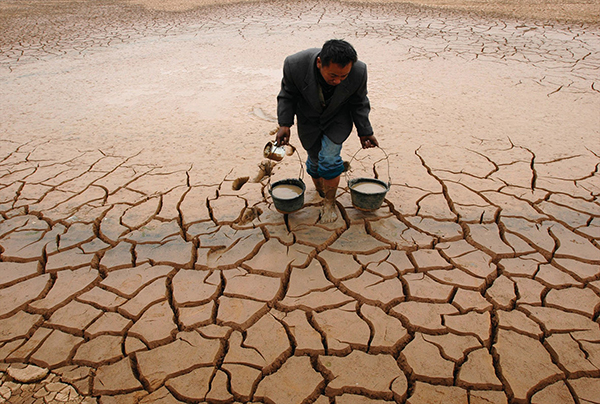
The severe drought conditions being experienced in many regions of the world may lead to competition for fresh water resources.
To make matters worse, demographic forces are not uniform. While populations in Africa are exploding, populations in the industrialized world are not only shrinking, but aging. Japan’s population is aging faster than any other nation. The population of Russia is falling by almost three quarters of a million people per year as a result of tuberculosis, alcohol, AIDS, suicide, abortion, and other social ills. Similarly, the population of Western Europe is shrinking dramatically. The upshot of these powerful asymmetries is that enormous osmotic forces have developed, propelling people out of Saharan and sub-Saharan Africa into Europe, out of Mexico and Central America into the United States, and out of China to the developed world. For the most part, these migrants are illegals. One can only presume, deterministically, that as the population of the developing world (and of those states that seem to have almost no prospects of ever developing) continues to grow relentlessly, the movement of people worldwide will become even more intense and potentially violent.
How are we to feed and provide energy for this burgeoning planetary community? Forty years ago it was a near-heresy to suggest that the world was running out of oil. Now “peak oil” is conventional wisdom. Bit by bit we are coming to terms with the fact that supplies of sweet crude are not inexhaustible. While there are variations in the outlook (for example a vast new oil field off Sao Paulo, Brazil), the underlying trend remains unchanged. There are fewer and fewer major discoveries. The appetite for energy on the part of the new oil-fired economies of Asia is insatiable. The price of a barrel of oil continues to rise through one psychological threshold after another. For all its appeal, ethanol appears to be the Piltdown Man of the energy world — half a hoax, half evolutionary dead end. While sugarcane biomass and algae hold out some promise, all the corn in the United States destined for conversion to ethanol (roughly 33 percent of the national crop) only produced five billion gallons in 2007, a figure equivalent to the production of one oil rig off the coast of West Africa. Furthermore, experience has revealed that it takes very nearly a barrel of oil to produce a barrel of ethanol. If those figures were not sobering enough, we have to face the likelihood that global automotive traffic will rise dramatically over the next 20 years — most of it in the developing world. Carlos Ghosn, the chief executive of Renault and Nissan, has calculated that the current number of passenger cars, 650 million, will rise to 2.9 billion by 2050.What does this mean in a world where there is relatively little elasticity in oil availability? What does greater energy consumption mean in terms of greenhouse gases and climate change? What impact will greater and greater oil scarcity mean on petroleum products like fertilizer, the cost of which doubled in 2007?
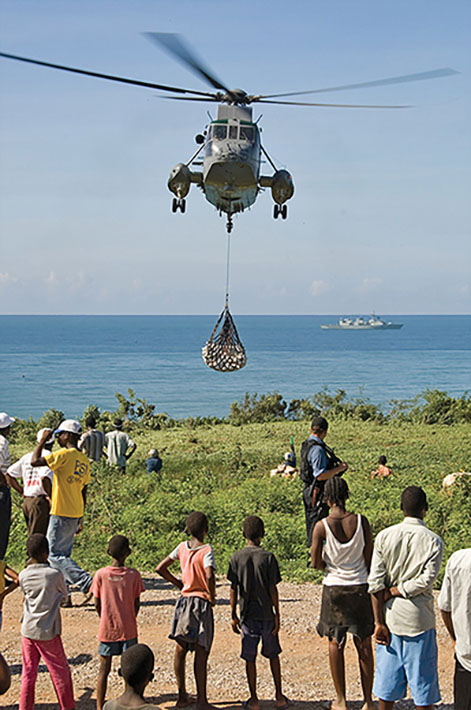
Scenes such as this of the Canadian Navy delivering humanitarian aid to Haiti in September 2008 are bound to become even more common in the decades ahead.
There are, of course, other considerations. If sweet crude supplies are becoming increasingly finite, what about the harder to extract stocks, the ones that come from tar sands or oil shale? The former entail a number of hard choices. The energy required to produce oil from tar sands contributes materially to global warming. And what is less well known is that it takes four barrels of water to produce one barrel of oil in this way.
Water is another of the resources coming under increasing strain. North Americans are monstrously profligate in their use of water: 350 litres per person per day in residential areas compared with 10 to 20 litres a day in sub-Saharan Africa. Water scarcity is becoming increasingly evident in the Middle East, in South Asia, and in Northern China. On many occasions in the past three decades, the Yellow River, one of the great rivers of China, has run dry before reaching its mouth. The Chinese have a saying, “When you drink the water, remember the spring,” but as a planetary society we have forgotten this adage. Over one billion people on earth lack access to clean drinking water and breathtaking riverine pollution in Asia is certain to drive that figure upwards. What, we should ask, is the nexus between water scarcity and interstate conflict? The forecasts are dark. Global warming will exacerbate the water situation and shifts in the diet of peoples in the developing world (it takes 1,000 litres of water to produce a kilogram of wheat and 13 times as much to produce a kilogram of beef) hold out little hope that the situation will be ameliorated in the short to mid-term.
Rising oil prices, the diversion of food stocks into alternative energy sources, the increased cost of fertilizers and herbicides, and the increasing scarcity of water are placing intolerable strains on global food production. In the developing and pre-developing world, individuals often spend the bulk of their income on two things — energy and food. Many have called for another Green Revolution, but the agricultural revolution of the 1960s and 1970s appears to have run its course. For the first time in human history there are more people living in cities than in the countryside. These people are at the mercy of local, national, or international food producers, but there are a host of structural impediments to the worldwide movement of inexpensive food. It is a tragic commonplace now to speak of farmers in Western Europe being paid to destroy their crops while millions starve elsewhere. And our life-long expectation that somehow science will come to our rescue, as it has done so many times before, seems a fatally arrogant presumption. There is hubris in our belief that science is the silver bullet. We have pushed the planet to the brink, and even stereotypically inexhaustible sources like the fish in the sea have begun to run out. Indeed, we are told that 90 percent of all the top predators in the world’s oceans are gone and that more than two-thirds of global fish stocks are at, or beyond, their sustainable limits. This is a matter of enormous consequence in view of the billions of people around the world who depend on the sea for their protein.
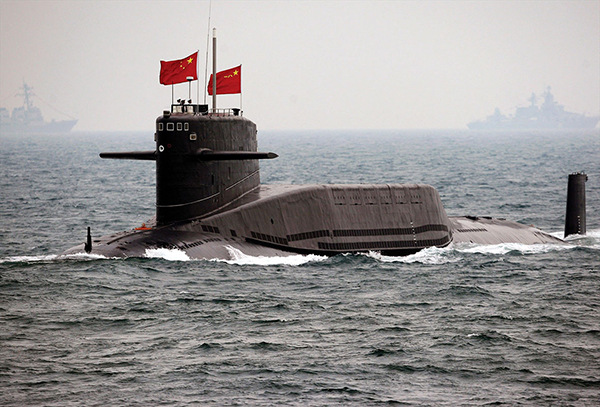
The Qingdao fleet review in April 2009, celebrating the 60th anniversary of the founding of the People’s Liberation Army Navy, marked the first time China has displayed its nuclear-powered submarines, a sign of its aspirations to become a major sea power.
What is particularly daunting is the speed with which these phenomena are unfolding. Or perhaps, correspondingly, the lamentable slowness with which we have read the writing on the wall. Many of these existential developments were foreseeable, but, motivated by a deadly amalgam of greed and self-denial, we chose to ignore these realities. In no other arena is this more the case than with global warming. What is truly alarming is the speed and magnitude of this phenomenon. While there are those who can point to earlier periods in geological history when the earth’s temperature rose, never in human history has it risen so quickly. Twelve of the last 15 years have seen the highest temperatures in recorded history. And what is even more frightening is that scientists from many walks of life are forecasting that climate change will trigger feedback loops within the next quarter century that will accelerate the rate of warming. Twenty-five years is the day after tomorrow in political terms and governments around the world seem content to tinker cosmetically at the margins. Disturbingly, a recent opinion poll in Great Britain revealed that 70 percent of voters were not willing to pay higher taxes in order to combat climate change. Thus, even the most ecologically assertive leaders are in retreat at the very moment when radical changes in energy consumption have become imperative.
What does this dismal recitation mean in the final analysis? We know with near mathematical certainty that the population of the earth will be about 8.3 billion by 2025. That is very nearly where our certainty runs out. Oil does seem to be a finite commodity, but how fast will we expend the global reserves? There is already evidence that increased fuel costs are having an impact on global shipping patterns and air travel. But are these merely variations on a theme? The upward trend in oil utilization and cost seems to be well established. Societal reactions seem unlikely to change those trends significantly. Even if they do, it appears to be a case of simply postponing the day of reckoning. And what is the interaction between demographic forces, energy availability, food, fresh water, and the environment?
All these phenomena are having a pronounced effect on world systems. Momentarily, oil prices are reinforcing authoritarian trends in countries like Russia, Venezuela, and Iran. Indeed, the corrupting influences of high energy revenues are well documented. While, in broad terms, democracy has been on the move globally over the past 40 years, that process may be slowing. There is widespread schadenfreude about the apparently diminished status of the United States (and its fiscal condition does warrant genuine concern), but the United States remains an enormously important and powerful player on the world stage. There even appears to be some reason for optimism in Iraq. What makes the United States particularly influential is not just the extent of its hard and soft power, but the fact that it is able to advance a universal vision of freedom and democracy. No other emerging power has such an animating philosophy. China has none, nor does India, and Russia’s message to the world is demonstrably bankrupt.
What is intriguing is the fact that while the developed world may account for 70 percent of global economic activity, the developing world is the driver of globalization. American power has been reduced in relative terms and after a fleeting moment of media-exaggerated unilateralism, Washington is increasingly open to multilateralism for pragmatic if not philosophical reasons. Balance of power politics has begun to reassert itself, and “coalitions of the willing” or “communities of democracies” are expressions of a jaded and beleaguered vision of the world emanating from Washington.
What does this mean for navies, and the Canadian Navy in particular? To begin with, as the historian Paul Kennedy and others have noted, the shift in the world centre of gravity from the Atlantic to the Pacific has been accompanied by a corresponding shift in naval power. The straitened circumstances in which the Royal Navy finds itself (who could imagine that what was once the greatest navy on earth would be abandoned to such a degree by its island people?) and the steady diminution in the number of vessels in the United States Navy (not to mention the malaise surrounding contemporary shipbuilding programs) lend credence to the Kennedy thesis.
The Europeans have moved into a post-modern age, where, weary of centuries of internal conflict, they have begun to forfeit Westphalian notions of national sovereignty voluntarily and to seek some larger sense of community. The European Union, with its rather effete and self-denying responses to international threats, stands in stark contrast to the robustly self-confident nationalism appearing in East Asia. East Asia is a complex arena — historically, geographically, and jurisdictionally. China and India have become unabashedly Mahanian in their pursuit of naval power to deal with these challenges, by adopting the “great battle fleet” concepts described by the nineteenth-century American sea power advocate, Admiral Alfred Thayer Mahan. In psychological terms, they are exhibiting the will to rule, something the Europeans have lost and the Americans are tiring of.
The upshot of all this is that Western navies are going to be increasingly hard-pressed to execute their traditional tasks. Demographic pressures are going to mount and this will place a premium on monitoring and/or interdicting greater and greater flows of illegal migrants seeking to make their way into the developed world. These flows will be both spontaneous and organized. One of the truly critical phenomena associated with the end of the Cold War (which “liberated” an array of criminal forces in the one-time Soviet Union; forces in league with intelligence agencies, the private sector, and politicians) and the continued progress of globalization, with its destruction of global barriers, has been the remarkable expansion of international organized crime. Autonomous criminal elements, dedicated to smuggling, counterfeiting, prostitution, and so forth, have proven to be far more nimble and adaptive than the hierarchically organized, anti-crime agencies that seek to combat them. The former have been able to act well inside the decision-making curve of counter-criminal bureaucracies, which are constrained by legal inhibitions and inadequate budgets. As Moises Naim has noted, “despite massive efforts, governments are failing to stem the tide of illicit trade.”2 Navies and coast guards have long been engaged in trying to stem the flow of drugs, human trafficking, and other illegal activities at sea, and there seems every reason to believe that by 2025 they — the Canadian Navy included — will be even more committed to this constabulary role.
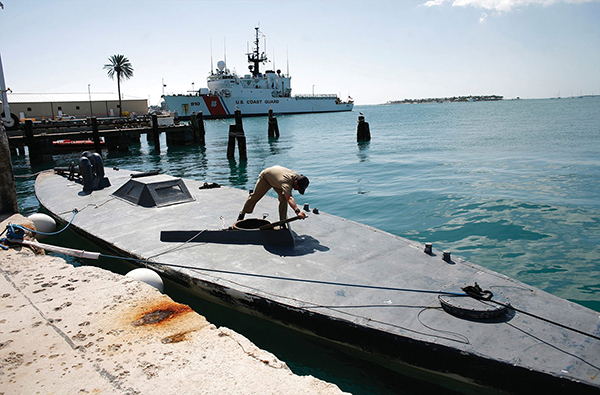
Cartels operating the Colombian cocaine trade are using homemade semi-submersible ships to transport up to 70 percent of the drugs leaving the country’s Pacific coast.
Successive Canadian governments have promised but almost invariably failed to live up to their commitments in areas such as overseas development and defence. With aging populations in North America (a condition ameliorated marginally by migration), will governments in 2025 be any different? Indeed, they will be even less likely to allocate the funds necessary to ensure an adequately equipped and manned (another ongoing demographic challenge) Canadian Forces. Many years ago Norman Augustine forecasted presciently that the average unit cost of weapons would continue to mount sharply. As one wag has observed, the United States might end up spending its entire defence budget on a single aircraft by 2025. As John Christie notes, “it may be hard for most people to believe that our [American] defense establishment is in a serious decline at a time when we are spending more than $400 billion a year on defense … However, the facts bear out this alarming state of affairs. U.S. defense forces will continue to shrink and age and we rapidly will cease being a dominant military force in the world unless we make major changes soon.”3
Presumably the CF and the navy will be subject to the same imperatives. Will successive governments forfeit Canada’s international presence — as they have already done in a number of arenas — in the face of mounting defence acquisition costs? Will there be countervailing pressures brought to bear by Washington (and, no doubt other capitals in pursuit of the “community of democracies” construct or latter-day variants) to do more of what we have already been doing — supplementing U.S. Navy operations globally?
Clearly, our ability to do so will be determined largely by the number of ships that are built in the next 15 years. By then, we should have a new fleet; but what will it look like? To what extent will the Canadian Navy be the victim of a zero sum game in which ships destined for the Arctic have come at the expense of those traditional mid-sized, blue water combatants that are critical to the nation’s global role? Or will a re-animated Canadian Coast Guard have assumed many of the maritime responsibilities in the Arctic — an arena that by 2025 should be open to fairly significant amounts of commercial traffic and offshore exploration and exploitation?
How would a new Canadian Navy function outside the Arctic? Terrorism of the sort that we have grown accustomed to since 9/11, if not before, will probably have run its course. The medieval, millenarian Al Qaeda movement, having failed to realize its goals to any considerable degree, will be largely discredited even in the eyes of the faithful. That is not to say that there will not be the occasional threats of terrorism. Afghanistan and Iraq will be behind us, but the nagging underdevelopment of the Arab world, coupled with the social ferment caused by a corrosive sense of envy, impotence, and marginalization (elevated and legitimated by recourse to a higher religious cause), will continue to fuel terrorist activity. But the Canadian Navy is likely to be far more engaged in combating organized crime, in all its many dimensions, than prosecuting a “War on Terror” at sea.
Climate change and the continued growth of urban coastal populations seem certain to dictate a continued humanitarian assistance and disaster relief role for the Navy. What is less certain is what are the interstate (and even intrastate) implications of mounting resource scarcity. Wood, water, and wheat will be the new currencies of 2025. Will states fight over diminished fish stocks? In view of the current rates of fish stock depletion and the continued presence of illegal fishers, there seems every likelihood that there will be clashes at sea, particularly in the geographically complex waters of the Indian and Pacific Oceans. Will the Western Pacific Naval Symposium, for example, act as a catalyst to bring navies and coastguards together in regional fisheries patrols? Probably so.
At the same time, more traditional demands are likely to impinge upon the Canadian Navy. Despite profound internal weakness, China will be the unquestioned hegemonic power of East Asia by 2025. Canadian interests in the Pacific will be far more clearly recognized than they are now and there will be national and international (read the “Five Eyes,”4 plus Japan, South Korea, India, and potentially others) pressure to maintain what amounts to a balance of naval power over and against China. Thus, a Standing Naval Force Pacific, ostensibly to provide peace and good order on the Ocean’s commons, but designed to incorporate (and hedge against) the Chinese Navy will probably be a prominent feature of the maritime realm of 2025.
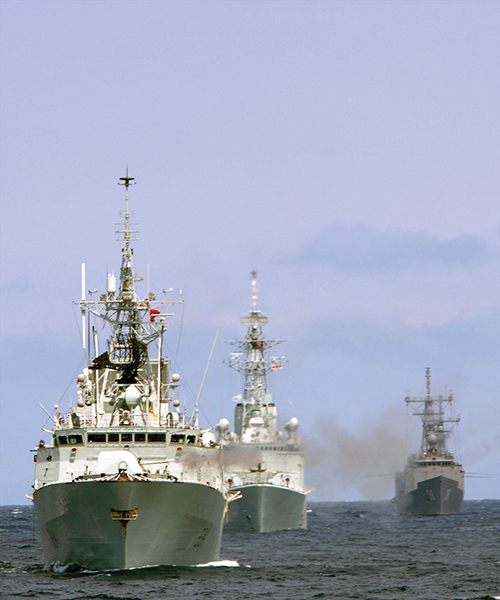
Sailing into the future: Her Majesty’s Canadian Ships Regina (in the lead, gun firing) and Algonquin, with an American frigate during Exercise Trident Fury 2007.
The fundamental changes that seem certain to occur by 2025 are existential in character, and will — individually or collectively — strain the global social fabric profoundly. The world in 2025 will be an increasingly problematic place, where threats to the established order will be commonplace, whether in the form of domestic instability, severe weather, transnational crime, mounting demographic pressures (destabilizing youth bulges, rapidly aging and diminishing populations, impoverished peoples, and legal and illegal migration), critical resource shortages, or progressive global warming. What is difficult to divine is just how all of these elements will interact and just how human intervention will shape that interaction.
Navies will be vitally important to ensuring good order in the face of these global phenomena. The Canadian Navy’s role will be dictated in considerable part by the nature of the assets it acquires over the next decade and a half. The constant contraction of naval resources, on the specious grounds that each new generation of ships is more capable than the one that preceded it, must be prevented. More ships rather than less should be the order of the day. A “Little Canada” home game strategy must be resisted. The world of 2025 will require a global naval presence more than ever before, whether to combat illegal fishing, the illegal movement of people, disaster relief, or the more traditional “balance of power” naval role. The world will be increasingly Hobbesian, “political will” shall still be in short supply, despite incontrovertible signs of a planet under serious stress, and navies like the Canadian Navy will be needed to range the world’s oceans ameliorating conditions of hardship and maintaining the peace.
Author: James Boutilier
1 Professor Danforth Middlemass, Dalhousie Centre for Foreign Policy Studies, Maritime Security Conference, 12 June 2008.
2 Moises Naim, Illicit (New York: Anchor Books, 2005), 217.
3 John D. Christie, “DoD on a Glide Path to Bankruptcy,” U.S. Naval Institute Proceedings (June 2008), 25.
4 This term is derived from the long-established agreement on intelligence sharing (“eyes only”) among the “AUSCANNZUKUS” allies: Australia, Canada, New Zealand, United Kingdom, and United States.